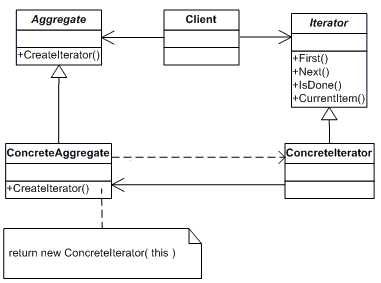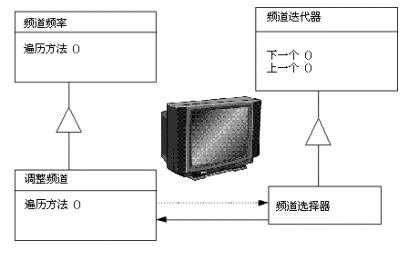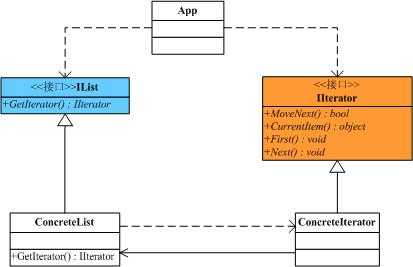标签:
概述
在面向对象的软件设计中,我们经常会遇到一类集合对象,这类集合对象的内部结构可能有着各种各样的实现,但是归结起来,无非有两点是需要我们去关心的:一是集合内部的数据存储结构,二是遍历集合内部的数据。面向对象设计原则中有一条是类的单一职责原则,所以我们要尽可能的去分解这些职责,用不同的类去承担不同的职责。Iterator模式就是分离了集合对象的遍历行为,抽象出一个迭代器类来负责,这样既可以做到不暴露集合的内部结构,又可让外部代码透明的访问集合内部的数据。
意图
提供一种方法顺序访问一个聚合对象中各个元素, 而又不需暴露该对象的内部表示。[GOF 《设计模式》]
结构图
Iterator模式结构图如下:

图1 Iterator模式结构图
生活中的例子
迭代器提供一种方法顺序访问一个集合对象中各个元素,而又不需要暴露该对象的内部表示。在早期的电视机中,一个拨盘用来改变频道。当改变频道时,需要手工转动拨盘移过每一个频道,而不论这个频道是否有信号。现在的电视机,使用[后一个]和[前一个]按钮。当按下[后一个]按钮时,将切换到下一个预置的频道。想象一下在陌生的城市中的旅店中看电视。当改变频道时,重要的不是几频道,而是节目内容。如果对一个频道的节目不感兴趣,那么可以换下一个频道,而不需要知道它是几频道。

图2 使用选频器做例子的Iterator模式对象图
Iterator模式解说
在面向对象的软件设计中,我们经常会遇到一类集合对象,这类集合对象的内部结构可能有着各种各样的实现,但是归结起来,无非有两点是需要我们去关心的:一是集合内部的数据存储结构,二是遍历集合内部的数据。面向对象设计原则中有一条是类的单一职责原则,所以我们要尽可能的去分解这些职责,用不同的类去承担不同的职责。Iterator模式就是分离了集合对象的遍历行为,抽象出一个迭代器类来负责,这样既可以做到不暴露集合的内部结构,又可让外部代码透明的访问集合内部的数据。下面看一个简单的示意性例子,类结构图如下:

图3 示例代码结构图
首先有一个抽象的聚集,所谓的聚集就是就是数据的集合,可以循环去访问它。它只有一个方法GetIterator()让子类去实现,用来获得一个迭代器对象。
 /// <summary>
/// <summary>
 /// 抽象聚集
/// 抽象聚集
 /// </summary>
/// </summary>
 public interface IList
public interface IList
 {
{ IIterator GetIterator();
IIterator GetIterator(); }
}抽象的迭代器,它是用来访问聚集的类,封装了一些方法,用来把聚集中的数据按顺序读取出来。通常会有MoveNext()、CurrentItem()、Fisrt()、Next()等几个方法让子类去实现。
 /// <summary>
/// <summary>
 /// 抽象迭代器
/// 抽象迭代器
 /// </summary>
/// </summary>
 public interface IIterator
public interface IIterator {
{ bool MoveNext();
bool MoveNext();
 Object CurrentItem();
Object CurrentItem();
 void First();
void First();
 void Next();
void Next(); }
}具体的聚集,它实现了抽象聚集中的唯一的方法,同时在里面保存了一组数据,这里我们加上Length属性和GetElement()方法是为了便于访问聚集中的数据。
 /// <summary>
/// <summary>
 /// 具体聚集
/// 具体聚集
 /// </summary>
/// </summary>
 public class ConcreteList : IList
public class ConcreteList : IList {
{ int[] list;
int[] list;
 public ConcreteList()
public ConcreteList()
 {
{ list = new int[] { 1,2,3,4,5};
list = new int[] { 1,2,3,4,5}; }
}
 public IIterator GetIterator()
public IIterator GetIterator()
 {
{ return new ConcreteIterator(this);
return new ConcreteIterator(this); }
}
 public int Length
public int Length
 {
{ get { return list.Length; }
get { return list.Length; } }
}
 public int GetElement(int index)
public int GetElement(int index)
 {
{ return list[index];
return list[index]; }
} }
}具体迭代器,实现了抽象迭代器中的四个方法,在它的构造函数中需要接受一个具体聚集类型的参数,在这里面我们可以根据实际的情况去编写不同的迭代方式。
 /// <summary>
/// <summary>
 /// 具体迭代器
/// 具体迭代器
 /// </summary>
/// </summary>
 public class ConcreteIterator : IIterator
public class ConcreteIterator : IIterator
 {
{ private ConcreteList list;
private ConcreteList list;
 private int index;
private int index;
 public ConcreteIterator(ConcreteList list)
public ConcreteIterator(ConcreteList list)
 {
{ this.list = list;
this.list = list;
 index = 0;
index = 0; }
}
 public bool MoveNext()
public bool MoveNext()
 {
{ if (index < list.Length)
if (index < list.Length)
 return true;
return true;
 else
else
 return false;
return false; }
}
 public Object CurrentItem()
public Object CurrentItem()
 {
{ return list.GetElement(index) ;
return list.GetElement(index) ; }
}
 public void First()
public void First()
 {
{ index = 0;
index = 0; }
}
 public void Next()
public void Next()
 {
{ if (index < list.Length)
if (index < list.Length)
 {
{ index++;
index++; }
} }
} }
}简单的客户端程序调用:
 /// <summary>
/// <summary>
 /// 客户端程序
/// 客户端程序
 /// </summary>
/// </summary>
 class Program
class Program
 {
{ static void Main(string[] args)
static void Main(string[] args)
 {
{ IIterator iterator;
IIterator iterator;
 IList list = new ConcreteList();
IList list = new ConcreteList();
 iterator = list.GetIterator();
iterator = list.GetIterator();
 while (iterator.MoveNext())
while (iterator.MoveNext())
 {
{ int i = (int)iterator.CurrentItem();
int i = (int)iterator.CurrentItem(); Console.WriteLine(i.ToString());
Console.WriteLine(i.ToString());
 iterator.Next();
iterator.Next(); }
}
 Console.Read();
Console.Read();
 }
}
 }
}一个简单的迭代器示例就结束了,这里我们并没有利用任何的.NET特性,在C#中,实现Iterator模式已经不需要这么麻烦了,已经C#语言本身就有一些特定的实现,下面会说到。
.NET中的Iterator模式
在.NET下实现Iterator模式,对于聚集接口和迭代器接口已经存在了,其中IEnumerator扮演的就是迭代器的角色,它的实现如下:
 public interface IEumerator
public interface IEumerator
 {
{ object Current
object Current {
{ get;
get; }
}
 bool MoveNext();
bool MoveNext();
 void Reset();
void Reset();
 }
}属性Current返回当前集合中的元素,Reset()方法恢复初始化指向的位置,MoveNext()方法返回值true表示迭代器成功前进到集合中的下一个元素,返回值false表示已经位于集合的末尾。能够提供元素遍历的集合对象,在.Net中都实现了IEnumerator接口。
IEnumerable则扮演的就是抽象聚集的角色,只有一个GetEnumerator()方法,如果集合对象需要具备跌代遍历的功能,就必须实现该接口。
 public interface IEnumerable
public interface IEnumerable
 {
{ IEumerator GetEnumerator();
IEumerator GetEnumerator(); }
}下面看一个在.NET1.1下的迭代器例子,Person类是一个可枚举的类。PersonsEnumerator类是一个枚举器类。这个例子来自于http://www.theserverside.net/,被我简单的改造了一下。
 public class Persons : IEnumerable
public class Persons : IEnumerable 
 {
{  public string[] m_Names;
public string[] m_Names; 
 public Persons(params string[] Names)
public Persons(params string[] Names)  {
{  m_Names = new string[Names.Length];
m_Names = new string[Names.Length]; 
 Names.CopyTo(m_Names,0);
Names.CopyTo(m_Names,0);  }
} 
 private string this[int index]
private string this[int index]  {
{  get
get  {
{  return m_Names[index];
return m_Names[index];  }
} 
 set
set  {
{  m_Names[index] = value;
m_Names[index] = value;  }
}  }
}
 public IEnumerator GetEnumerator()
public IEnumerator GetEnumerator() {
{ return new PersonsEnumerator(this);
return new PersonsEnumerator(this); }
} }
}

 public class PersonsEnumerator : IEnumerator
public class PersonsEnumerator : IEnumerator {
{ private int index = -1;
private int index = -1;
 private Persons P;
private Persons P;
 public PersonsEnumerator(Persons P)
public PersonsEnumerator(Persons P) {
{ this.P = P;
this.P = P; }
}
 public bool MoveNext()
public bool MoveNext() {
{ index++;
index++;
 return index < P.m_Names.Length;
return index < P.m_Names.Length; }
}
 public void Reset()
public void Reset() {
{ index = -1;
index = -1; }
}
 public object Current
public object Current {
{ get
get
 {
{ return P.m_Names[index];
return P.m_Names[index]; }
} }
} }
} 来看客户端代码的调用:
 class Program
class Program  {
{  static void Main(string[] args)
static void Main(string[] args)  {
{  Persons arrPersons = new Persons("Michel","Christine","Mathieu","Julien");
Persons arrPersons = new Persons("Michel","Christine","Mathieu","Julien"); 
 foreach (string s in arrPersons)
foreach (string s in arrPersons) 
 {
{  Console.WriteLine(s);
Console.WriteLine(s);  }
}
 Console.ReadLine();
Console.ReadLine();  }
}  }
}程序将输出:
 Michel
Michel 
 Christine
Christine 
 Mathieu
Mathieu 
 Julien
Julien现在我们分析编译器在执行foreach语句时到底做了什么,它执行的代码大致如下:
 class Program
class Program 
 {
{  static void Main(string[] args)
static void Main(string[] args)  {
{  Persons arrPersons = new Persons("Michel","Christine","Mathieu","Julien");
Persons arrPersons = new Persons("Michel","Christine","Mathieu","Julien"); 
 IEnumerator e = arrPersons.GetEnumerator();
IEnumerator e = arrPersons.GetEnumerator(); 
 while (e.MoveNext())
while (e.MoveNext())  {
{  Console.WriteLine((string)e.Current);
Console.WriteLine((string)e.Current); 
 }
}
 Console.ReadLine();
Console.ReadLine(); }
}  }
}可以看到这段代码跟我们最前面提到的示例代码非常的相似。同时在这个例子中,我们把大部分的精力都花在了实现迭代器和可迭代的类上面,在.NET2.0下面,由于有了yield return关键字,实现起来将更加的简单优雅。下面我们把刚才的例子在2.0下重新实现一遍:
 public class Persons : IEnumerable
public class Persons : IEnumerable  {
{  string[] m_Names;
string[] m_Names; 
 public Persons(params string[] Names)
public Persons(params string[] Names)  {
{  m_Names = new string[Names.Length];
m_Names = new string[Names.Length]; 
 Names.CopyTo(m_Names,0);
Names.CopyTo(m_Names,0);  }
} 
 public IEnumerator GetEnumerator()
public IEnumerator GetEnumerator()  {
{  foreach (string s in m_Names)
foreach (string s in m_Names)  {
{  yield return s;
yield return s;  }
}  }
}  }
} 
 class Program
class Program  {
{  static void Main(string[] args)
static void Main(string[] args)  {
{  Persons arrPersons = new Persons("Michel","Christine","Mathieu","Julien");
Persons arrPersons = new Persons("Michel","Christine","Mathieu","Julien"); 
 foreach (string s in arrPersons)
foreach (string s in arrPersons)  {
{  Console.WriteLine(s);
Console.WriteLine(s);  }
}
 Console.ReadLine();
Console.ReadLine();  }
}  }
}程序将输出:
 Michel
Michel 
 Christine
Christine 
 Mathieu
Mathieu 
 Julien
Julien实现相同的功能,由于有了yield return关键字,变得非常的简单。好了,关于.NET中的Iterator模式就说这么多了,更详细的内容大家可以参考相关的资料。
效果及实现要点
1.迭代抽象:访问一个聚合对象的内容而无需暴露它的内部表示。
2.迭代多态:为遍历不同的集合结构提供一个统一的接口,从而支持同样的算法在不同的集合结构上进行操作。
3.迭代器的健壮性考虑:遍历的同时更改迭代器所在的集合结构,会导致问题。
适用性
1.访问一个聚合对象的内容而无需暴露它的内部表示。
2.支持对聚合对象的多种遍历。
3.为遍历不同的聚合结构提供一个统一的接口(即, 支持多态迭代)。
总结
Iterator模式就是分离了集合对象的遍历行为,抽象出一个迭代器类来负责,这样既可以做到不暴露集合的内部结构,又可让外部代码透明的访问集合内部的数据。
参考资料
Erich Gamma等,《设计模式:可复用面向对象软件的基础》,机械工业出版社
Robert C.Martin,《敏捷软件开发:原则、模式与实践》,清华大学出版社
阎宏,《Java与模式》,电子工业出版社
Alan Shalloway James R. Trott,《Design Patterns Explained》,中国电力出版社
MSDN WebCast 《C#面向对象设计模式纵横谈(18):Iterator 迭代器模式(行为型模式)》
.NET设计模式(18):迭代器模式(Iterator Pattern)(转)
标签:
原文地址:http://www.cnblogs.com/sandea/p/4320400.html